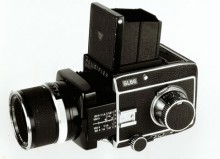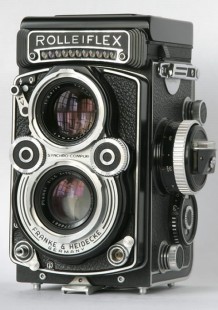The Rolleiflex SL66 is a most interesting camera and for those of us who attended the Club annual ‘get-together’ in November at the Millstream Hotel, now the home of Club Rollei, we were very lucky. Stephen Coe a very well known and respected advertising photographer gave a talk on his favourite camera, The Rolleiflex SL66.
As Stephen told his audience, his SL66 was his ‘bread earner’ and also paid his rent! There is no doubt that the Rollei SL66 was a very strong camera that withstood many knocks and heavy usage, but on the downside was a heavy camera.
Another Club Rollei member, who’s preferred professional camera, was also the SL66, is Michael Warren, whose Photos Horticultural company, found the macro facility with the built in bellows was of great benefit.
In 1953, two days before I married Hazel, Herr Weiss who was Rollei’s chief designer, told me that he had seen a Hasselblad SLR medium format camera. Had I heard anything about this camera? I suggested that we telephoned Dollands the well-known opticians who had a very good professional camera department. The person I spoke to suggested that I bought a Rolleiflex TLR, much more reliable than the new Hasselbald 1600 that they were selling. He told me that he had sold two Hasselblads and both were faulty. Worse still, no spares were available.
After a year, the Hasselblad was replaced by the 1000 model. This was not much better, and on the 13th February 1954 the last Hasselblad 1000 left the factory. But Hasselblad were not beaten, along came the 500C, and there can be no doubt that this camera was well received by professionals and the Rollei TLR lost a lot of potential sales to the 500C.
Rollei decided that the Hasselblad design had merits, so Herr Weiss was asked to design a Rollei medium format SLR. Carl Zeiss were asked to tender for a lens for this camera, in fact similar lenses as supplied to Victor Hasselblad.
Victor Hasselblad first thought about designing a medium format camera way back during World War 2, in 1941. Victor saw a German Handkammer HK medium format SLR using 80mm perforated film that was on a German Luftwaffe aeroplane, that crashed in Sweden. The Swedish Air force asked Victor to design and make a prototype camera. A camera that could be fitted with a tele lens and used for aerial reconnaissance.
The German camera had a fixed 80mm lens whereas Victor’s camera could accept interchangeable lenses made by either Schneider or Zeiss. The production Hasselblads first used Kodak lenses as Hasselblad’s family business were the Kodak importers into Sweden.
Ian Carron, now a retired photographic dealer in Australia will remember Rollei showing him the new SL66 in 1956 and telling him that this camera will surely be a Hasselblad killer! It was not. The focal plane shutter primarily doomed it from the start.
Rollei promoted the Scheimflug principal to increase depth of field. As Ian Carron said, many photographers confuse this with perspective correction, an entirely different principle.
Last week at the Hotel de France in Jersey, I noticed a man with a Hasselblad metal case. He proudly showed me his new tool, a Hasselblad digital camera. The camera had the usual look of a 500C Hasselblad, but the workmanship was brilliant. He had three lenses and a flash unit of three heads. I was very envious until I found out that the camera complete with one lens and digital back costs around £28,000.
With a compact flash card I took a number of portrait shots with the Hasselblad. I was able to take just 44 shots before the 1 GB card was filled. I also took some similar shots with my Rolleiflex 2.8GX TLR. Both cameras used available light with only a reflector. The results?
“Well that saved you some money!” retorted my wife, Hazel, when she saw the results. The A3 enlargements from the Rollei film camera were way ahead of the Hasselblad. The pro photographer was truly surprised at the results. But as he said, I can take some shots with the digital camera and print the results in a few minutes. Film takes a day or so longer.
There can be no doubt that a digital camera has many advantages over film, but I am of the opinion that the results from a good 35mm film camera are almost as good as a medium format digital camera. Today, with Photoshop, you can do a lot with digital printing on an ink jet printer.
Perhaps I am getting old, having now turned 80 when you read this. With the Hasselblad camera that was fitted with a prism finder, I had to stoop down when taking my portraits, so that the model’s head was in the right position. It is so much easier to look down on the Rollei TLR screen when taking portraits and to ensure that the background around the model’s head is the sky. It is easier to change your position with Rollei TLR.
I shall continue to use my 2.8GX, it is light, and after all we have been friends for almost 80 years.

